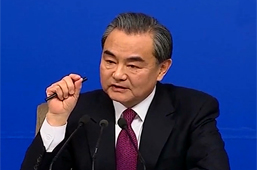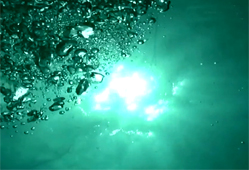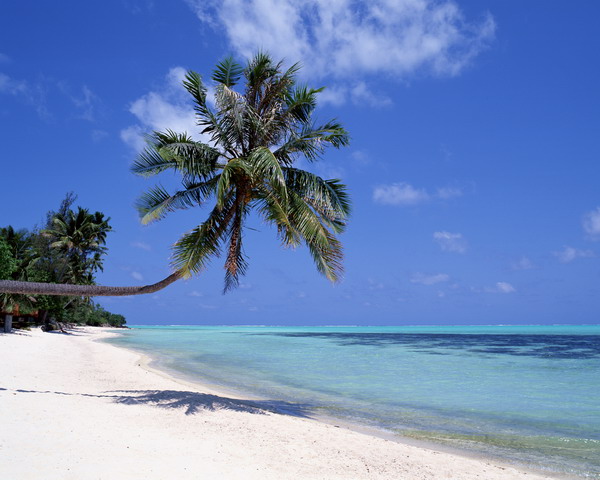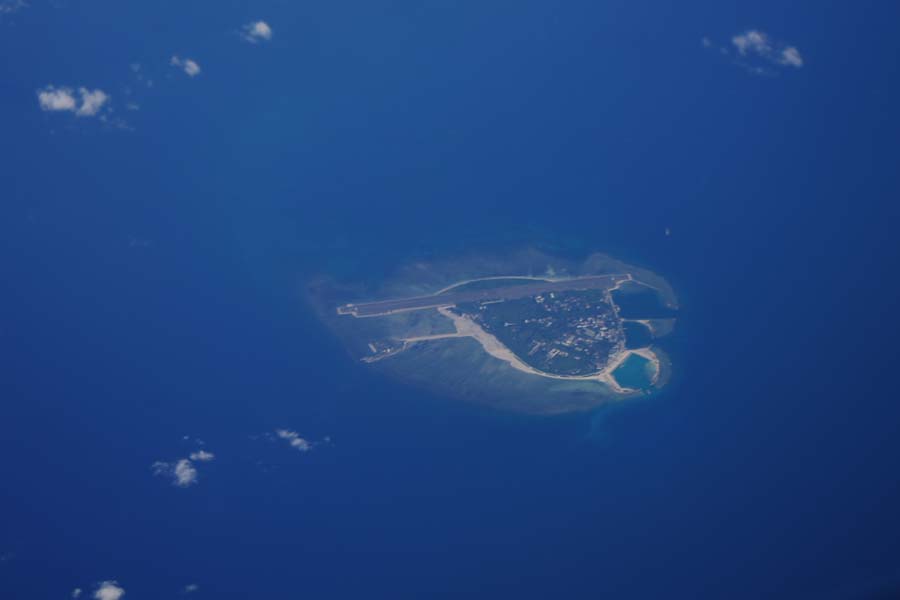(1) The First China-Malaysia Joint Committee Meeting on Maritime Science and Technology Convened
The First China-Malaysia Joint Committee Meeting on Maritime Science and Technology was held in Beijing on March 11, 2010. A Chinese delegation headed by Deputy Administrator Chen Lianzeng of the SOA and a Malaysian delegation headed by Fadillah Yusof, Vice Minister of Science, Technology and Innovation of Malaysia attended the meeting. The Joint Cooperation Committee reached consensus after discussion to prioritize five cooperative projects in the following two years. They are: development and application of maritime forecast, seasonal oscillation and interactions of cold waves in Southeast Asian waters, assessment of sediment distribution in the South China Sea, study on ecosystem and biodiversity, and maritime and coastal management and its technological support. The committee also decided to set up a steering group for the implementation of bilateral cooperation projects. Both sides agreed to hold a Joint Committee meeting and a seminar biennially.
(2) The First China-Malaysia Seminar on Maritime Sciences Held
After discussion between the two sides and in accordance to the Agreement on Cooperation in the Field of Maritime Science and Technology between the Government of People's Republic of China and the Government of Malaysia, the first China-Malaysia Seminar on Maritime Sciences was held in Beijing from March 9 to 10, 2010. A Chinese delegation headed by Director General Zhang Zhanhai of the International Cooperation Department of the State Oceanic Administration and a Malaysian delegation headed by Khadija Yusof, Deputy Secretary-General of the Ministry of Science, Technology and Innovation of Malaysia attended the seminar. Officials from both sides delivered reports on China-Malaysia Maritime Technology Cooperation: Retrospect and Prospect. Experts from the two countries had discussions on the following four topics: tackling maritime climate change and disaster prevention and mitigation; maritime ecosystem health and environmental protection; maritime sustainable development and comprehensive management of coastal zone; and participation in international organizations and international cooperation programs. 28 suggestions on cooperation have been proposed for the discussion of the Joint Committee Meeting.
(3) Malaysia Pilots China's Ocean Forecasting System
Xia Changyong and Wang Guansuo from the First Institute of Oceanography, SOA completed on October 29, 2012 the installation of the Ocean Forecasting System and provided training for Malaysian staff in Labuan, Malaysia, where the Ocean, Meteorology and Hydrology Bureau of Malaysian Meteorological Department is located.
With remote assistance from experts of the High Performance Computing Center of the First Institute of Oceanography and of the State Key Laboratory of Maritime Environmental Sciences and Numerical Modeling, Wang Guansuo succeeded in installing the wave-tide-circulation coupled numerical forecasting system with a complete technical file in the computing platform of the Ocean, Meteorology and Hydrology Bureau of Malaysia. The system was designed and built by the physical oceanography group of the First Institute of Oceanography, SAO. The system had been in operation since November 5, 2012, providing 72-hour forecasts for wave, three dimensional temperatures, three dimensional circulation and water level, etc. Ocean affairs fall within the business of State Meteorological Department of Malaysia as there is no organization like Maritime Administration in the country. As the first comprehensive maritime environment prediction system in Malaysia, this forecasting system was certain to enhance its capabilities of maritime environment forecasting and provide technological support for disaster prevention and mitigation, shipping safety, and ecological protection.
After the installation, Xia Changyong and Wang Guansuo gave a training lesson to Malaysian staff, which covered basic principles of ocean numerical model, POM, MASNUM wave model, circulation coupling theory, circulation-coupled numerical model, parallel computing principles, turning sequential model to parallel computing, the operation of maritime forecasting system, etc. Above 10 officials from the State Meteorological Department of Malaysia and its branches took part in the training. After the training in both theory and operation, as they mastered not only basic principles of maritime numerical modeling but also the process of maritime forecast, they were issued with certificates signed by Ms. Che Gayah Ismail. She also sent appreciation letters to Xia Changyong and Wang Guansuo.
The Malaysian side expressed gratitude to State Oceanic Administration of China and the First Institute of Oceanography for the system installation and training. Ms. Che Gayah Ismail, head of Malaysian Meteorological Department, sent letters of thanks to the two organizations on November 16, 2012, and expected support from the Chinese side for future system upgrading.
(4) The Second China-Malaysia Joint Committee Meeting on Maritime Science and Technology Held
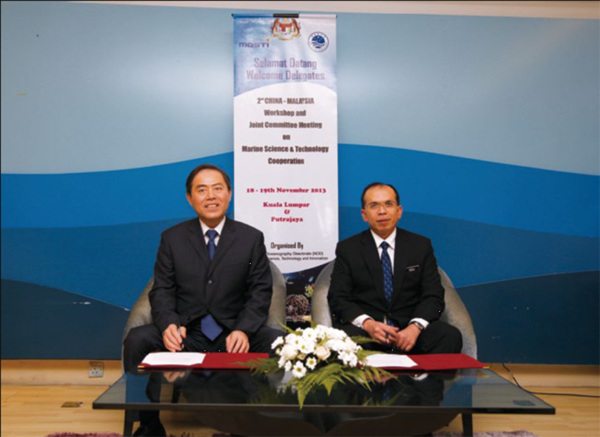
The Second China-Malaysia Joint Committee Meeting on Maritime Science and Technology was held in Kuala Lumpur on November 19, 2013. A delegation of the State Oceanic Administration headed by Deputy Administrator Chen Lianzeng attended the meeting. Entrusted by Abu Bakar Mohamad Diah, Deputy Minister of Science, Technology and Innovation of Malaysia, Dato' Dr Rosli Mohamed, secretary general of the Ministry, co-hosted the meeting with Vice Minister Chen. The two sides reached consensus on five aspects in promoting China-Malaysia cooperation in maritime science.
Mr. Chen gave a brief introduction of the organization structure and functions of the State Oceanic Administration and invited the Minister of Science, Technology and Innovation to the APEC Ocean-Related Ministerial Meeting in 2014. Five proposals were made by Deputy Administrator Chen in promoting bilateral cooperation. First, to prioritize key cooperation areas, co-developing the Five Year Plan for China-Malaysia Cooperation on Maritime Science and Technology (2014-2018) and applying for the China-ASEAN Maritime Cooperation Fund; Second, to maintain the high standard of China-Malaysia Joint Committee Meeting, boosting the status of maritime cooperation in bilateral strategic partnership; Third, to strengthen communication and coordination to support the establishment of China-ASEAN Maritime Cooperation mechanism; Fourth, to welcome Malaysia's recommendation of outstanding young scholars in applying for Chinese Government's Ocean Scholarship; Fifth, to renew relevant agreements when appropriate.
Secretary General Dato' Dr Rosli Mohamed pointed out that President Xi Jinping's visit to Malaysia in October 2013 had pushed the bilateral relations to a new height and laid a solid political foundation for bilateral cooperation in maritime science and technology. The Malaysian side attached great importance to maritime cooperation with China and was willing to strengthen ties between Malaysian maritime authorities and research institutes with their Chinese counterparts, advancing mutually beneficial programs. The Malaysian side remained positive to a long-term and table China-ASEAN Ocean Cooperation Mechanism and expressed gratitude to the Chinese side for both the scholarship for young Malaysian scholars and its invitation to the Minister.
They reached consensus in terms of the future corporation in the following five aspects: First, to set up a working group for formulating the Five-Year Plan; Second, to select one or two projects in application for the China-ASEAN Maritime Cooperation Fund; Third, to maintain the high standard of the Joint Committee Meeting and establish a three-level mechanism—the Joint Committee Meeting (Minister level), the Guiding Committee (Director General level) and Project Working Group (Expert level)—to ensure project running; Fourth, to renew cooperation agreements and deepen cooperation in maritime science and technology; Fifth, to promote exchanges in staff training and capacity expansion.
The delegation also visited the Malaysian Meteorological Department and the National University of Malaysia. Staff of the Malaysian Meteorological Department briefed on the application of the wave-tide-circulation coupled numerical model, a joint project by the First Institute of Oceanography, SOA and the Malaysian side. The Department showed great interest in the tsunami warning system and disaster relief mechanism, which was led by China. The Malaysian side was ready to have collaboration with China in tsunami buoys deployment and data sharing, etc., so as to boost the capabilities of both countries of maritime disaster prevention and mitigation. The delegation also visited Chai Xi, Chinese Ambassador to Malaysia.
(5) China and Malaysia Are to Co-chair the ASEAN Regional Forum Disaster Relief Exercises (ARF DiREx)
In preparations for the ASEAN Regional Forum Disaster Relief Exercises (ARF DiREx), a delegation composed by officials from the Ministry of Foreign Affairs, State Oceanic Administration, General Staff Headquarters, and the Ministry of Civil Affairs, etc., paid a visit to Malaysia from August 18 to 22, 2014 for field inspection and in-depth consultations.
When signing the Joint Communiqué between the People's Republic of China and Malaysia in Conjunction with the 40th Anniversary of the Establishment of Diplomatic Relations in May 2014, Premier Li Keqiang of China and Prime Minister Dato' Sri Mohd Najib of Malaysia announced that the two countries were to co-host the ARF DiREx from February 1 to 6, 2015. After that, the two sides started preparations for the exercise and jointed hands in making specific plans. The simulation exercise to be held in Malaysia will include Table Top Exercise (TTX) and Field Training Exercise (FTX). FTX is composed by Onshore Exercise, which will cover scenarios like building collapse, leakage of hazardous chemicals, car accident with chemicals, individuals marooned in an islet, and landslide, etc., and Maritime Exercise that will include scenarios like cruise relief.
The Chinese delegation inspected exercise fields suggested by Malaysia and had detailed discussions with its Malaysian counterparts concerning exercise schemes. The Malaysian side had done a lot for the exercise and the schemes it proposed were detailed and feasible. The two sides were to refine the exercise schemes and work on Commander Center and field construction.
(6) A Delegation of the Third Institute of Oceanography, SOA Visited Malaysia
From April 27 to May 1, 2015, a six-member delegation of the Third Institute of Oceanography, SOA paid a visit to the University of Malaysia and the Maritime Park Development of Malaysia.
On the afternoon of April 28, the delegation visited the Maritime Park Department of Malaysia. A discussion between the two sides was chaired by Dr. Sukarno Bin Wagiman, Director General of the Maritime Park Department and participated by members from the Ministry of Natural Resources and Environment, Foreign Ministry of Malaysia and the University of Malaysia. Delegation Chief Chen Jian briefed on the purpose of the visit while researcher Liu Zhenghua made a report on "Proposals on the Construction of China-ASEAN Maritime Park Ecomanagement Network". AB Rahim Bin GorYaman, Chief of the Division of Planning and Management of the Maritime Park Department delivered a representation on "the Status Quo of Malaysian Maritime Park Construction and Management" with special focus on the construction of maritime parks, their distribution, protection, and development, tourism development in particular. The two sides had in-depth discussion about ecological protection and management, and both believed that it was of great importance to strengthen cooperation in maritime ecosystem and blue economy among China, Malaysia and other ASEAN member states. The Malaysian side applauded cooperation projects proposed by the Chinese side, and aimed at stronger communication between the two governments concerning specific requirements and project implementation via the State Oceanic Administration of China and the Ministry of Natural Resources and Environment. This informal discussion helped fulfilled the purpose of the visit and laid a solid foundation for the construction program of China-ASEAN Maritime Park Ecomanagement Network.
On the afternoon of 28 and on 29 April, the delegation visited the Institute of Ocean and Earth Science (IOES), University of Malaysia, and had a meeting with Vice President of the university and over 20 experts of IOES. On April 30, accompanied by Prof. Azizan Abu Samah, Vice Director of IOES, delegation members paid a visit to The IOES Bachok Maritime Research Station in Kelantan and gained considerable achievements. The Malaysian side valued the visit and convened a high level conference hosted by Prof. Dr. Noorsaadahbd. Rahman, Vice President of the University of Malaysia, who was responsible for research management. The two sides had a thorough discussion on their cooperation conducted and progress achieved as well as the aim of this visit. Both sides spoke highly of where they have reached and expressed high expectations for future cooperation. The projects were hoped to be carried out through effective communication. The Malaysian side would offer a supporting fund for projects and hoped that Chinese institutes and R&D enterprises could establish a training exchange platform and provide Malaysian students and young researchers with short- and medium-term training programs. On April 29, experts from the Third Institute of Oceanography, SOA and IOES, University of Malaysia had academic exchanges on "research on maritime biotechnology, resource development and utilization, and blue economy" and "study on maritime ecological protection and selecting pilot sites for the project of assessment on ecosystem of the South China Sea inshore waters and its management tactics". After effective discussion, experts of both sides arrived at initial consensus about cooperation.
Prof. Phang Siew Moi, Director of IOES accompanied the delegation in a visit to an algae cultivation experiment base and a maritime biotechnological R&D laboratory. While showing their R&D achievements in maritime biological products and introducing their relatively easy policies for international technological cooperation, the Malaysian side also expressed an interest in utilizing Chinese funding for joint research.
On the evening of April 29, the delegation visited the Bachok Maritime Research Station of the University of Malaysia in Kota Bahru, capital city of Kelantan. Associate Prof. Lim Po Teen, head of the station, showed the delegation atmospheric observation facilities and a research lab for harmful algae (red tides) and expressed hope for cooperation with China and maritime buoy observation. He also elaborated on coral reefs and algae types in Perhentian Island, an island near Bachock Station. The two sides had an in-depth discussion on schemes for a pilot site and joint training in the future.
Against the background of China's promoting the Belt and Road Initiative, and with the opportunity of Malaysia acting as the rotating president of ASEAN this year, this visit, which had been carefully organized and efficiently promoted, achieved expected results.












